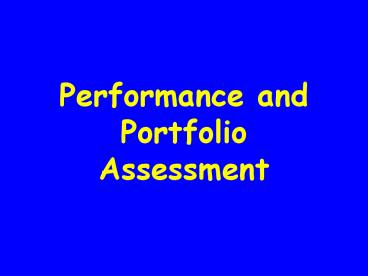Science fair projects are examples. Performance Assessmen - PowerPoint PPT Presentation
1 / 18
Title:
Science fair projects are examples. Performance Assessmen
Description:
Science fair projects are examples. Performance Assessment Techniques. Group Projects ... Primarily used for assessing learning in science. ... – PowerPoint PPT presentation
Number of Views:221
Avg rating:3.0/5.0
Title: Science fair projects are examples. Performance Assessmen
1
Performance and Portfolio Assessment
2
Performance Assessment
- An assessment in which the teacher observes and
makes a judgement about a students demonstration
of a skill or competency in creating a product. - Similar terms include
- authentic assessment.
- alternative assessment.
- portfolio assessment
3
Performance Assessment Techniques
- Individual Projects.
- Group Projects.
- Interviews and Oral Presentations.
- Constructed Response Questions.
- Essays.
- Experiments.
- Demonstrations.
4
Performance Assessment Techniques Individual
Projects
- Comprehensive demonstrations of skills or
knowledge. - Usually require student initiative and
creativity. - Trained judges (often teachers) score projects
against predetermined standards of quality. - Science fair projects are examples.
5
Performance Assessment Techniques Group Projects
- Similar to individual projects.
- A number of students work cooperatively on a
complex problem. - Trained judges (often teachers) score projects
against predetermined standards of quality.
6
Performance Assessment Techniques
Interviews/Oral Presentations
- Allow verbalization of knowledge.
- Interviews are particularly effective with
younger children. - Examples of usage include foreign language
assessment, and - Solutions to math or science problems.
7
Performance Assessment Techniques Experiments
- Primarily used for assessing learning in science.
- Several national organizations (e.g., AAAS, NSTA,
NSF) advocate the use of experiments in classroom
assessment of science concepts. - Again, trained judges (often teachers) score
projects against predetermined standards of
quality
8
Performance Assessment Techniques Demonstrations
- Give students the opportunity to show their
mastery of subject-area content and procedures. - In physics, for example, use pulleys, gears, and
inclined planes to move objects.
9
Performance Assessment Techniques Portfolios
- Collections of student work provide a portrait of
individual performance over time. - Typically, students are asked to evaluate the
work they select for inclusion.
10
Performance AssessmentAdvantages and Limitations
- Advantages
- Assessment of complex, higher-order learning
targets. - Students actively engaged in learning while being
assessed. - Forces teachers to use multiple criteria.
- Limitations
- Weaker reliability.
- Limited sampling of learning targets.
- Time-consuming.
- Not good for assessing knowledge learning targets.
11
Performance AssessmentMost Serious Limitation
- Limited Generalizability
- Students respond to fewer tasks.
- Makes it difficult to draw inferences about
general abilities. - If the performance is successful can we infer
that the student would do well on other tasks? - If performance is unsuccessful can we infer that
the student would do poorly on other tasks?
12
Performance AssessmentsThree essential
components
- Popham contends, and most experts agree, that a
performance assessment should contain the
following three components - Multiple criteria.
- Pre-specified quality standards.
- Judgmental appraisal.
- In addition, performance assessments can be
either simulated or authentic.
13
Performance AssessmentComponents (Popham)
- Identify the purpose for the assessment.
- Identify the learning target.
- Identify activities that illustrate acquisition
of the targeted capability. - Identify the types of evidence needed to infer
skill acquisition. - Identify the standards to be used.
- Place all this in the rubric.
14
Performance AssessmentEvaluating the Rubric
- Does it identify critical components of the
learning target? - Does it identify observable behaviors or
outcomes? - Is it appropriate for the students being
assessed? - Does it apply across contexts that call for
similar behaviors? - Does it specify levels of accomplishment?
15
Vehicles for RecordingEvidence of Skill
Acquisition
- Rating Scales
- Assess the degree or adequacy of attainment of
the learning target. - Checklists
- Assess presence or absence of skill acquisition.
- Anecdotal Records
- Assess atypical or unusual behaviors on selected
children for future reference.
16
PortfoliosAdvantages and Limitations
- Advantages
- Authenticity.
- Show growth.
- Empower students.
- Foster communication.
- Great instruc-tional tool.
- Limitations
- Many uses of classroom assessment are not served
well with portfolios. - Time consuming.
- Psychometric problems
- with validity.
- with reliability.
17
Portfolio Assessment
- Assessment or instruction aid?
- Types of portfolios
- Purposeful portfolios.
- Document progress.
- Showcase accomplishments.
- Evaluate student status.
- Work-sample portfolios ( Document typical
performance). - Appraising portfolios (Scored w/ a rubric).
18
End































